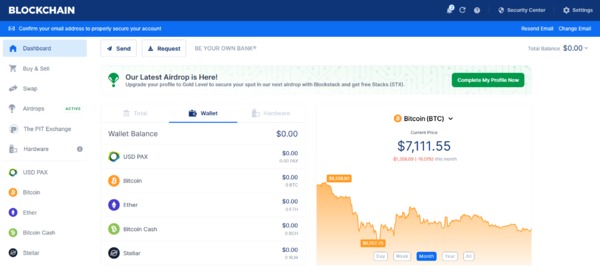
One of the most important steps in your bitcoin education is learning how to get a bitcoin wallet. When you’re dealing with bitcoin you act as your own bank, which means you’re responsible for the storage and security of your digital assets.
In this guide, you’ll learn how to get a bitcoin wallet, which is your first step towards becoming your own bank and sovereign individual.
What is a Bitcoin Wallet?
A bitcoin wallet is a place where you store, send, and receive bitcoin. It can be thought of as a digital bank account.
Each wallet has one or many bitcoin addresses. These addresses are where you receive bitcoin, where you store it, and where you draw it from when you send it to someone else.
Which Bitcoin Wallet Should I Choose?
There are many different wallets to choose from for managing bitcoin. Some are software wallets you install on your PC. Others are web-based wallets or mobile applications. Still other wallets are physical hardware wallets that you can carry around with you. Each type of wallet has its pros and cons.
Mobile wallets are great for spending bitcoin and for having easy access to your bitcoin, but they aren’t too secure. The same is true of web-based wallets. Both of these types are suitable for small amounts of bitcoin, usually no more than a few hundred dollars worth.
Then, there are the software wallets that are installed on your computer. They are more secure but aren’t very convenient if you need access to your bitcoin away from home. And they are really only as secure as your own PC.
Finally, there are hardware wallets. These are designed to be the most secure, and promise to keep your bitcoin safe from bad actors and hackers.
How to Get a Bitcoin Wallet
In this guide on how to get a bitcoin wallet, we’re going to use the web-based wallet at blockchain.com as an example. Blockchain is one of the most trusted and fastest-growing companies in the bitcoin space, and their wallets have been downloaded over 44 million times. It offers a free wallet, either as a mobile app or as a web-based wallet. While these aren’t the safest way to store your bitcoins they are a good way for beginners to get started. They are also suitable for small amounts of bitcoin.
The first thing to do is head over to the blockchain.com website. Once there, you’ll immediately see the bright orange button to “Get a Free Wallet.” Click it to get started.

You’ll be taken to the signup form to get your free wallet. There you’ll need to enter a valid email address and a password of your own choosing. Tick the box to agree to the Terms of Service and Privacy Policy (after reading them of course), and click the “Create My Wallet” button.

After a couple of seconds, you’ll see a message displayed in the upper right of the website that says “Wallet Successfully Created.” After a few more seconds you’ll automatically be logged into your wallet.

And that’s all there is to it! You can use your new wallet to receive bitcoin and several other cryptocurrencies or to send them to others. The blockchain.com wallet also allows you to buy and sell bitcoin through their partner Coinify.
You can also perform swaps between the supported cryptocurrencies. Swap is Blockchain’s in-wallet, non-custodial crypto-to-crypto exchange. Swap allows users to quickly and easily exchange one crypto asset for another, without having to use fiat currency as an intermediary and without ever leaving your Blockchain Wallet. With Swap, you can quickly exchange between BTC, ETH, BCH, XLM, and PAX.

While the wallet at blockchain.com is a great start to managing bitcoin, if you plan on acquiring more than a couple hundred dollars worth you’ll really want to invest in a hardware wallet. These are considered the gold standard in bitcoin security.

The two most well-known hardware wallets are the Ledger Nano S and the Trezor. Both Ledger and Trezor have several models to choose from, with the base models being very affordable. Even the top-end models with their professional features are reasonably priced when you consider you might be storing tens of thousands of dollars worth of digital assets.
Another benefit to these hardware wallets is they have support for thousands of different digital assets. So, if you decide to expand your holdings beyond bitcoin you likely won’t have to think about getting a new wallet. You can just store the new coins in the same hardware wallet as your bitcoin.
Related Reading:
- 10 Best Bitcoin Online Web Wallets, Rated and Reviewed 2019
- Set Up and Update the Ledger Nano S and X Hard Wallet, Step by Step
- Lost Bitcoin? How to Restore Your Bitcoin Wallet
Want to learn how to invest that bitcoin you have secured wisely? Subscribe to the Bitcoin Market Journal newsletter today and join a vibrant community of like-minded blockchain and bitcoin investors!

